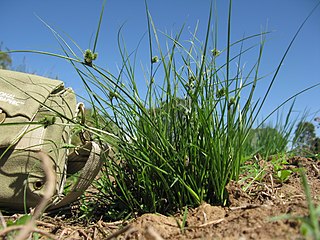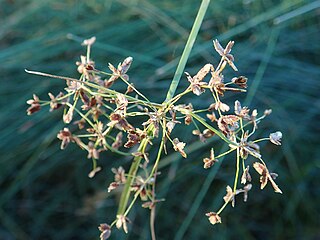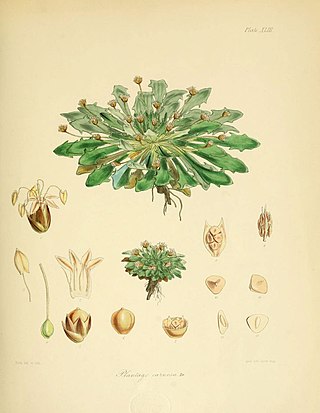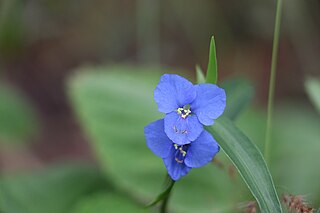
Dioscoreaceae is a family of monocotyledonous flowering plants, with about 715 known species in nine genera. The best-known member of the family is the yam.

Microtis, commonly known as onion orchids or mignonette orchids is a genus of about 20 species of plants in the orchid family, Orchidaceae. Onion orchids are terrestrial herbs with a single leaf at the base of the plant. They are similar to orchids in the genus Prasophyllum in that they have an onion-like leaf. The flowers are small but often scented and attractive to their insect pollinators. They are widespread in Asia, Australia and some Pacific islands.

Spinifex longifolius, commonly known as beach spinifex, is a perennial grass that grows in sandy regions along the seacoast. It also lives in most deserts around Australia.

Schoenus brevifolius, known as zig-zag bog-rush, is a species of sedge native to Australia, New Zealand, New Caledonia, and the Ogasawara (Bonin) Islands. It was first described by Robert Brown in 1810.

Johnsonia is a genus composed of five species of herbs in the family Asphodelaceae, all of which are endemic to the south-west of Western Australia. They are grass-like plants with minute flowers surrounded by bracts which are often tinged with white, pink or cream.

Persicaria decipiens, commonly known as slender knotweed, is a species of flowering plant native to Australia and Asia.

Cuscuta australis, commonly known as Australian dodder, is a herb in the family Convolvulaceae.

Carex inversa, commonly known as knob sedge, is a species of sedge of the family Cyperaceae that is native to parts of Australia and New Zealand and has also been introduced into Great Britain.

Cyperus concinnus is a sedge of the family Cyperaceae that is native to Australia, and found in New South Wales, Queensland, the Northern Territory, South Australia, Victoria and Western Australia.
Microtis rara, commonly known as the scented onion orchid, is a species of orchid endemic to Australia, with the exception of the Northern Territory. It has a single hollow, onion-like leaf and up to fifty small green or yellowish-green, scented flowers. It is similar to Microtis oblonga and some authorities regard the two as being one species.

Ptilothrix deusta is a sedge in the family Cyperaceae found in south eastern Australia. It is commonly seen in wet sandy soils in heathland, growing from 30 to 60 cm tall. This is one of the many plants first published by Robert Brown with the type known as "(J.) v.v." appearing in his Prodromus Florae Novae Hollandiae et Insulae Van Diemen in 1810 as Carpha deusta. It was transferred to the genus, Ptilothrix, in 1994 by Karen Wilson. The genus name is derived from ancient Greek, meaning feather hair. The specific epithet deusta is derived from the Latin with a meaning of burnt.

Plantago triantha is an annual plant of the family Plantaginaceae that is found in both Tasmania and the Auckland Islands.

Alternanthera denticulata is a small prostrate white-flowering herb in the Amaranthaceae family. It is native to all states and territories of Australia, New Guinea, and the North Island of New Zealand. It is also one of the food plants of the varied eggfly, Hypolimnas bolina nerina.
Leptocarpus laxus is a rush species of the genus Leptocarpus in the family Restionaceae. It is endemic to the south-west of Western Australia.

Samolus junceus in the family Primulaceae is a species of water pimpernel native to Western Australia.

Westringia rigida is a shrub in the Lamiaceae family that is endemic to Australia. and
Cyperus enervis is a species of sedge that is endemic to eastern Australia.
Polypogon tenellus is a species of annual grass in the family Poaceae, first described by Robert Brown in 1810. It is native to Western Australia and South Australia.

Schoenus pedicellatus is a species in family Cyperaceae, first described by Robert Brown in 1810 as Chaetospora pedicellata, but assigned to the genus, Schoenus, in 1811 by Jean Louis Marie Poiret. Note that GBIF and Plants of the World Online both give the genus change as being by Roem. & Schult. However the species is Australian and the text by Poiret is earlier than that of Roemer and Schultes.

Commelina lanceolata is a plant in the family Commelinaceae native to the Northern Territory and Queensland in Australia. It is a scrambling perennial herb first described by the Scottish botanist Robert Brown in 1810, who published his description in his work Prodromus Florae Novae Hollandiae et Insulae Van Diemen.
















